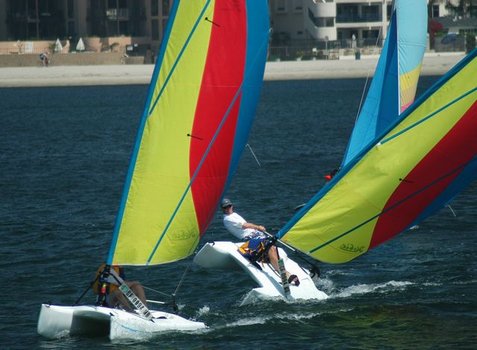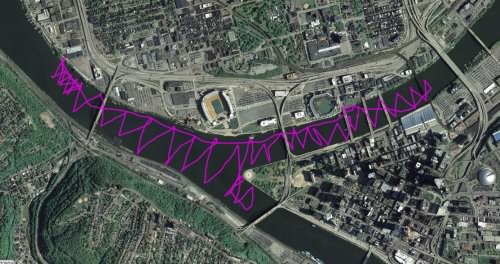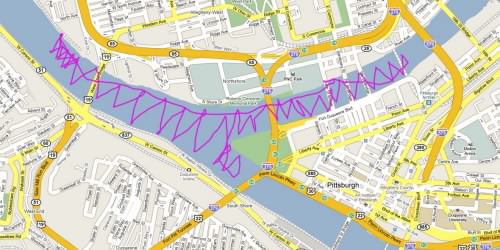Illusions
August 29, 2009
With the end of summer now approaching, I've been sailing often enough on the rivers for it to become routine. I keep an eye on the winds and currents; and when they are favorable and I am free, I load my bike and head off to the river. I am becoming complacent in my new-found river expertise. It is an easy illusion.
So it was today. The currents are low enough: 9,000 cubic feet per second on the Allegheny and 1800 cubic feet per second on the Mon. As expected, I could barely discern the current by watching debris floating by in the water.
The winds were predicted to be WSW at 10-12 mph. That matched my measurements as I paused in my cycling at the riverbank to hold my wind gauge high in the air. Now and then the winds did drop a little. I was a little concerned that the "S" component of the winds would mean that the winds would be obstructed by the hills on the Southern shore of the Ohio at the Newport marina, as they had on August 9th. When I arrived at the marina, I was pleased to find the winds blowing straight up the river against the meager current. The hills would be no problem today.
I arrived to find my boat enthroned on its launch ramp, constructed specially for me by the kind folk at the Newport marina. All I had to do was untie a few knots and it would slip into the water.
Preparing the boat had become so familiar that I was now carefully choosing each step to be carried out at the just the right moment to make things easy. The rudder would be attached in the shallows where I could stand behind the boat to fit it; and I would only swivel it vertically downward when I had the boat firmly moored at the deepest end of the pier. I put special effort into getting the main sheet--the rope that controls the sails through a pulley system--perfectly disentangled now. I was determined not to find myself struggling to get the last looping out later, somewhere in the middle of the river.
Here's the boat ready to sail:
I would be sailing up the river with the wind at my back. I still recalled how I'd struggled on August 9 under similar conditions to control a flapping sail. This time would be different. I would reef the sail. That is, I would keep most of it rolled up around the mast, so there is only a little area in the wind.
I shoved the boat off into the river and it was very soon apparent that this scheme would work. The amount of sail showing seemed so small. But the winds were strong enough to push the little boat as fast as 4-5 mph. That was all that was needed. It didn't seem worth the fuss and bother of a flapping sail to gain an extra one or two mph. I zig-zagged a little across the wind, since a sailboat running before the wind is easier to control with the wind slightly to one side. Otherwise there is always a danger of "jibing"--the sail suddenly flapping over to the other side.
The dangerous stretch of river was bounded by the West End Bridge. I knew from many earlier days that once I'd passed it, the sailing would get easier. It is the gateway to Pittsburgh.
As the wind swept me towards it, I was thinking how much harder the return sail would be, straight into the wind in this hardest section of river. As I gloated over the perfection of my planning, it hit me. I'D FORGOTTEN MY LIFE JACKET. It was still draped over the handlebars of my bicycle.

My heart sank and I felt completely naked. It is an odd feeling we have all had. You suddenly realize you left your bag or your this of your that; and then everything feels wrong. Alas, I needed to turn round and painfully tack back to the marina. What had taken two or three minutes before the wind, now took 20 minutes to return in this difficult stretch of river.
The episode cost me 30 minutes and also helped banish the illusion that I knew what I was doing. The illusion that I had passed novice ineptitude had been so powerful. You can see the comings and going in the GPS tracks below. The marina start is in the top left hand corner.
Otherwise, the sailing was straightforward and great fun. I went up the Allegheny. Its three bridges at 6th, 7th and 9th Street are my favorites. I docked briefly between 6th and 7th Street to stretch my legs and watch the kayakers.
I set the sail in its reefed position:
I sailed up as far as the railway bridge at the Convention Center and then headed back. Around the point, the winds were strong. On a beam reach, the wind blows directly from the side of the boat. It is the fastest point of sail. I started watching the little speedometer on my GPS receiver. On the fastest runs in which I was able to check, I was making 8.5 mph. There's so much happening on a sailboat--you are constantly adjusting both the sail and rudder and watching for other boats--that mostly I cannot look at the speedometer. I soon found the tip off that I had reached higher speeds. The wake behind the boad seems to swell and arch up in an impressive rising mound behind the boat.
The Gateway Clipper fleet was out in force; they were carrying spectators to the football game this evening at Heinz Field. I usual keep well away from big boats that might run me down. But in this wind, I was bold. I just kept sailing along, knowing that I had plenty of speed to avoid them. Indeed, I found that I easily outpaced the Just Ducky boats carrying sightseers. But then they are slow. It's the price paid, I suppose, for being able to drive through the city and straight into the water.
The winds were strong enough to make tacking hard again, as it had been on August 9. I learned nothing really new, but just got a little smarter. It became clearer that the root cause of the problem is rudder drag when I turn the bows towards the wind. As I turn, I can feel the boat decelerate abruptly and see the water gush up around the housing at the top of the rudder in a way that has to drag on the boat. There goes all the added speed needed to carry the bows past the eye of the wind, when the sail no longer powers it. I knew that one should not turn too quickly to tack. One should gently carve the turn in the water so that the minimum speed is lost. The pinciple was clear, but I just couldn't implement it reliably in practice, no matter how cautiously I cast my "helm alee"--that is, moved the tiller to the downwind side of the boat to commence the turn.
Some tricks worked. Reversing the rudder when the boat stalled pointing dead into the wind would eventually pull the bows over, as the wind pushed the boat straight back. But that only works if the bows have come round far enough. They hadn't always. I found I could always make the tack if the wind dropped, so I started to seek out the little spot of quieter air and water in the lee (=downwind) of a bridge piling. You'll see in the gps tracks that there a fewer loops where I had to resort to jibing to make the tack. (Click here and here for bigger versions.)
Unlike past tracks, this time, you'll notice that the tracks line up perfectly with the river shores. My son Jonathan figured out what was wrong with the earlier plots. Here's the solution to the mystery.
The zig-zags of my tacking into the wind show that the Bravo doesn't do badly in making headway into the wind. It is, roughly, always coming from the left--Western--edge of the map. Obstacles on the riverbanks tend to funnel the wind to run straight along the rivers. In these higher winds, I began to see that I was not trimming the sail to best effect when close hauled to the wind. The problem is that these winds can easily tip the boat if the sail is hauled in as tight as is needed to get the best aerodynamics. So I tended to let out the sail as the gusts came in and then haul it back again, when they passed. When let out, the sail would start to flap and I'd lose a lot of power.
A bolder sailor would keep the sail hauled in tight, but hike out--lean out over the water--to balance the boat. This is something I'd contemplate if there were no big river boats or barges to run me down if I tipped the boat; and if the river winds were steady enough for me to assured that they would not change every few moments. Both problems told me to choose prudence over bravado. (The sailor hiking out in his Bravo in this photo might be about to topple if he doesn't release the main sheet. What is curious is that the Bravo in front has its sail hauled in tight, but the boat is not heeling. Has the second caught an especially fierce little puff?)

I'd set out at 2:30 and it was 5:45 by the time the bows of my Bravo bumped up against the launch ramp at the marina. Eve and my daugher Josephine were out cycling. They arrived a little while later and we three together headed back along the river trail home.
We had not counted on the football game. We passed Heinz Field just as the crowds were arriving. We were once again struggling to make headway against the current. But this time it was a human current of Steelers fans, jubilant in their Steelers' jerseys.
Ours is an amazing city and downtown. I thought that perhaps today, at last, would be an ordinary day with nothing special scheduled. That was not a thought shared by this crowd and the growing collection of boats moored along the river's edge near.
John D. Norton
Back to main

